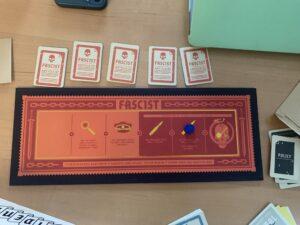I played ‘Secret Hitler’ designed by Max Temkin, Mike Boxleiter, and Tommy Maranges and manufactured by Breaking Games. We played the board game version.
The target audience is for players 17 and up. The game can be played with 5-10 players, but we played with 7 players. Each player can either play a ‘Liberal,’ ‘Fascist’ or ‘Hitler.’ The outcome of the game is to either have the Liberals or Fascists win. The Liberals’ objective is to either kill Hitler or obtain 5 liberal policies. Alternatively, Fascists’ (including Hitler) objective is to elect Hitler as Chancellor or to obtain 5 fascist policies.
The general procedure is as follows. For each round, we took turns being the President, who is able to elect a Chancellor. All players vote on whether or not the Chancellor is elected. The President picks up 3 policy cards and chooses to discard 1. From the remaining two cards, the Chancellor chooses a policy to enact. The President and Chancellor can strategically choose the policy they would most benefit from. As the rounds progress and the Fascist policies are gradually obtained, the President gains particular powers that can help reveal identities of other players (this way, there is an incentive to gaining Fascist powers). The board of powers is attached below.

Additional rules are that the same person cannot be elected Chancellor twice. The player who was previously President is also unable to be elected Chancellor.
I’ve played a very similar game called Resistance. The procedure and rules are basically identical. There are two teams, and the goal is to have your perspective to progress each round. However, from what I recall there is no player elimination and no player that dictates the outcome of the game, like Hitler in Secret Hitler. The premise was also completely different. Resistance’s two teams were the Resistance and the Spies. Instead of government analogies related to policies, the players either agreed to carry out (favorable of the Resistance) or sabotage a mission (favorable of the Spies). I think that the Resistance was easier to understand, since the government analogies of the Secret Hitler were a little daunting at first.
Secret Hitler was a really fun game! It was fun to be able to strategize with the group and try to deduce everyone’s role. The discussion each round was very playful and interactive, and at the end of our game, the secret Hitler was completely unexpected! This sense of fun was a success, even for all of our first times playing. Something I would consider a downfall of the game was the time it took to learn. It took about 30 minutes for us to actually understand and get used to the game. We also played it safe, and voted all of the Chancellors to be elected. It would have been more dramatic if we voted more Chancellors off.
I would suggest simplifying the premise to be easier to understand and quicker to gain traction. Another way to pick up the game is to allow more powers sooner in the game. This will prevent the game from being too stagnant and encourage more flow. The objective will be more clear quicker, allowing the outcome to result more efficiently.


